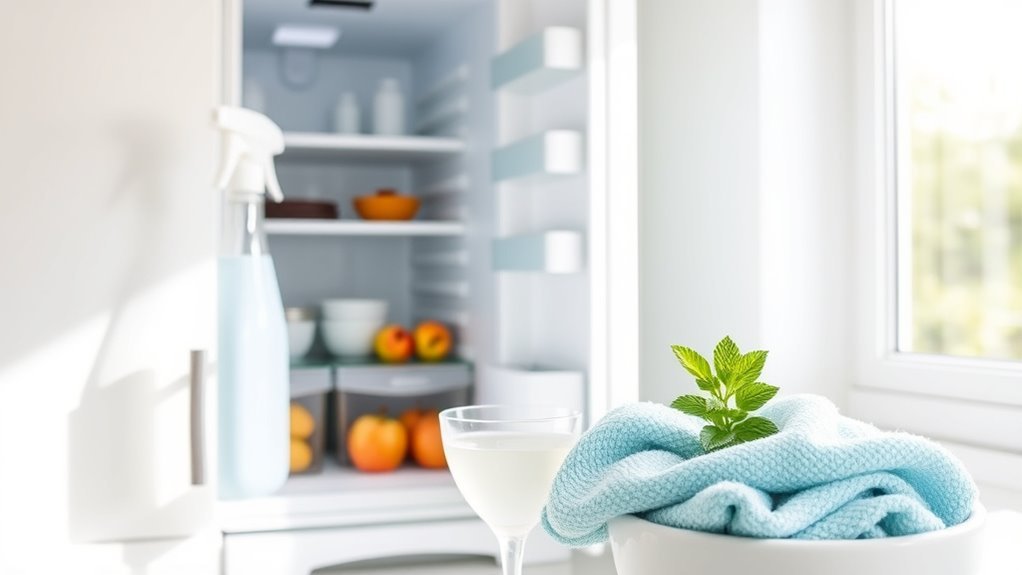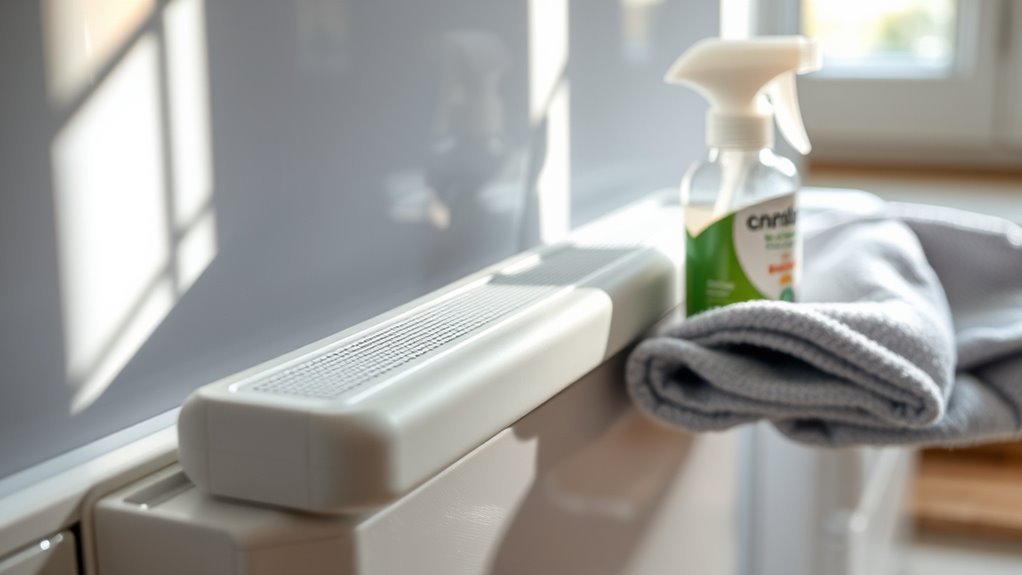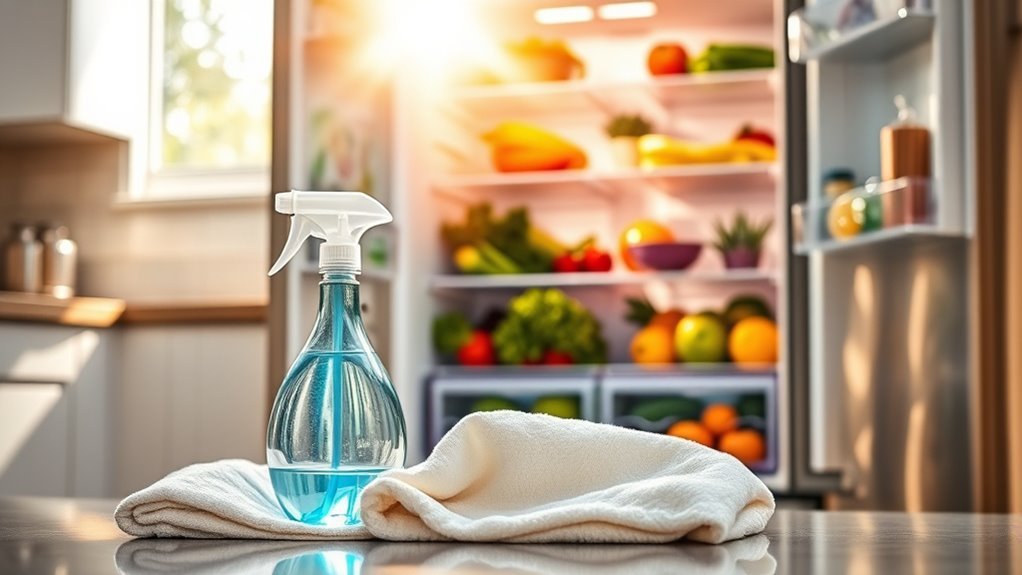Top 10 Tips for Cleaning Refrigerator
To clean your refrigerator effectively, start by emptying it completely and removing shelves and drawers for thorough washing with a gentle, natural cleaner. Wipe down interior surfaces and door seals carefully to avoid damage. Organize your food by category, check expiration dates, and discard anything expired. Don’t forget to clean the exterior and handles regularly, as they’re touched often. Keeping a regular cleaning schedule helps maintain freshness and efficiency. You’ll find lots more useful tips to keep your fridge spotless and well-maintained.
Empty Your Refrigerator Completely

Before you begin cleaning, you’ll want to empty your refrigerator completely. This step is essential for gaining full control over your space and making the process more efficient. Start by taking stock—create a refrigerator inventory to know what you have, what’s expired, and what you actually need. This not only clears out clutter but also frees you from unnecessary items weighing you down. Once emptied, gather your cleaning tools—like microfiber cloths, mild cleaners, and a bowl of warm soapy water—so you’re fully prepared to tackle every corner. Taking this moment to declutter and organize empowers you to maintain a fresh, clean fridge that supports your lifestyle without constraints. It’s about reclaiming your space and your freedom.
Remove and Clean Shelves and Drawers
With your refrigerator emptied and ready, the next step is to remove the shelves and drawers for a thorough cleaning. This step is essential for effective shelf maintenance and drawer organization, giving you control and freedom over your fridge space. Carefully take out each component, keeping track of their placement to ease reassembly.
| Feeling | Action | Result |
|---|---|---|
| Overwhelmed | Remove shelves/drawers | Clear workspace |
| Empowered | Clean thoroughly | Fresh, germ-free |
| Free | Organize drawers | Easy access |
| Satisfied | Maintain regularly | Long-lasting order |
| Motivated | Reinstall with care | Efficient storage |
This process liberates your fridge from grime and clutter, helping you regain control and enjoy the freedom of a clean, organized space.
Use a Gentle Cleaning Solution

One simple cleaning solution you can make uses just three ingredients: warm water, mild dish soap, and a splash of white vinegar. This combo is perfect for keeping your fridge clean without harsh chemicals. It lets you enjoy gentle scrubbing that protects surfaces while being tough on grime. Plus, it aligns with eco friendly solutions, helping you care for your home and the planet.
Clean your fridge naturally with warm water, mild dish soap, and white vinegar for gentle, effective grime removal.
Remember these tips when using your homemade cleaner:
- Use a soft cloth or sponge to avoid scratches
- Avoid abrasive cleaners that can damage surfaces
- Rinse with plain water to remove residue
- Dry thoroughly to prevent mold and odors
Wipe Down Interior Walls and Surfaces
Although cleaning the fridge’s interior may seem tedious, wiping down the walls and surfaces is essential to keep it fresh and hygienic. Grab your favorite cleaning tools—a soft cloth or sponge works best—to gently scrub the interior surfaces. Make sure to reach every corner, including under shelves, where spills can hide. Avoid harsh scrubbing to protect the fridge’s finish. Focus on removing stains, crumbs, and sticky spots that can attract bacteria or odors. By regularly wiping down these surfaces, you prevent buildup and maintain a clean environment for your food. Taking a few minutes for this step gives you freedom from lingering smells and messes, ensuring your fridge stays fresh and inviting every time you open it.
Clean the Refrigerator Door Seals

If you want your fridge to seal properly and keep cold air inside, cleaning the door seals is crucial. Neglecting this step can lead to energy loss and food spoilage. Regular seal maintenance not only guarantees a tight closure but also helps with mold prevention, keeping your fridge fresh and hygienic.
Cleaning fridge door seals is essential for energy efficiency, food safety, and mold prevention.
To clean the seals effectively, follow these tips:
- Use a soft cloth dipped in warm, soapy water to wipe down the seals.
- Pay attention to crevices where dirt and grime accumulate.
- Dry thoroughly to prevent moisture buildup, which encourages mold growth.
- Inspect seals for cracks or damage and replace if necessary.
Deodorize With Natural Ingredients
How can you keep your fridge smelling fresh without harsh chemicals? Simple—turn to natural ingredients like baking soda and vinegar solutions. Baking soda is a powerhouse deodorizer; just place an open box inside your fridge to absorb odors quietly and effectively. For a deeper clean, wipe down surfaces with a mild vinegar solution. Vinegar’s natural acidity breaks down residues that cause smells, leaving your fridge fresh without any synthetic scents. These natural options give you freedom from chemical-laden products, ensuring your food stays safe and your fridge smells clean. Regularly swapping out the baking soda and using vinegar solutions keeps odors at bay effortlessly. Embracing these natural deodorizing tips means you maintain a fresh fridge environment in a safe, eco-friendly way.
Organize Food Items Before Restocking
Before you restock your fridge, take a moment to organize your food items by category to make things easier to find. Check expiration dates to keep only fresh items on hand and avoid waste. Using clear storage containers can help you see what you have at a glance and keep everything tidy.
Categorize by Food Type
Although organizing your refrigerator might seem tedious, categorizing items by food type makes restocking faster and keeps your fridge tidy. When you separate your groceries, you gain freedom from the chaos and can easily find what you want without digging through piles. Focus on these key areas:
- Vegetable storage: Keep veggies in designated crispers to maintain freshness.
- Dairy organization: Store milk, cheese, and yogurt together, away from strong odors.
- Meat safety: Place raw meats on the lowest shelf to prevent drips contaminating other foods.
- Condiment placement: Group sauces and spreads in door compartments for easy access.
Don’t forget fruit preservation and snack arrangement—they’re just as important in creating a well-ordered, efficient space you’ll actually enjoy using.
Check Expiration Dates
While organizing your fridge, you’ll want to check expiration dates to confirm nothing past its prime stays inside. This simple step keeps your food fresh and protects your freedom from unexpected spoilage or illness. Use expiration reminders by marking dates on items or setting alerts on your phone, so you’re always aware of what needs to be used up soon. Keeping track of these dates not only saves you money but also confirms food safety, preventing harmful bacteria from developing. By regularly checking and discarding expired items, you maintain a clutter-free, efficient fridge that supports your healthy lifestyle. Taking control of your fridge this way lets you enjoy fresh meals without worry, giving you peace of mind and more time to focus on what truly matters.
Use Clear Storage Containers
Keeping track of expiration dates is just one part of maintaining a well-organized fridge. Using clear storage containers can transform your food organization, giving you freedom to see what you have at a glance and avoid waste. When you sort your groceries into containers with the right container sizes, you make restocking easier and keep everything neatly in place.
Here’s why clear containers work for you:
- Instantly spot what’s inside without opening lids
- Stack containers efficiently, saving space
- Choose container sizes that fit your fridge and food portions
- Maintain freshness by keeping items sealed and separated
Check and Discard Expired Products
You should start by checking the expiration dates on all your food items to spot anything past its prime. Once identified, make sure to dispose of expired products properly to keep your fridge clean and safe. This simple step helps prevent spoilage and keeps your food fresh longer.
Identify Expiration Dates
One of the easiest ways to keep your fridge clean and safe is by regularly checking expiration dates on all products. By paying close attention to the expiration label, you guarantee food safety and prevent spoiled items from lingering. This simple habit frees you from worrying about bad food and keeps your fridge organized.
Here’s how to quickly identify expiration dates:
- Look for the “use by,” “best before,” or “sell by” dates on packaging.
- Check dates on perishable goods like dairy, meat, and leftovers first.
- Rotate items so older products are in front and used sooner.
- Discard anything past its expiration date to avoid health risks.
Stay vigilant, and your fridge will stay fresh and safe, giving you the freedom to enjoy your food worry-free.
Proper Disposal Methods
Although it might seem tedious, properly disposing of expired products is crucial for maintaining a clean and safe refrigerator. When you check your fridge, toss anything past its prime without hesitation. Remember to follow local recycling guidelines for packaging like glass bottles or plastic containers to minimize waste. Some items, like certain cleaning agents or batteries you might store in the fridge, count as hazardous waste and need special disposal—never just throw them in the trash. Staying on top of this keeps your space fresh and helps protect the environment. By handling expired goods responsibly, you free yourself from clutter and guarantee your fridge is a safe zone for your food. It’s a small effort that brings big freedom in your kitchen.
Clean the Exterior and Handles
Since the exterior and handles of your refrigerator are touched frequently, they tend to collect dirt and germs quickly. To keep them spotless and germ-free, choose cleaning supplies suited for your fridge’s exterior materials—whether stainless steel, plastic, or painted surfaces. Avoid harsh chemicals that might damage finishes. Here’s how to tackle it effectively:
- Use a microfiber cloth to prevent scratches.
- Opt for mild soap or a vinegar-water solution.
- Clean handles daily, as they’re the highest-contact spots.
- Dry thoroughly to prevent streaks and water spots.
Maintain Regular Cleaning Schedule
Keeping your refrigerator clean on a regular schedule makes a big difference in hygiene and efficiency. To enjoy that freedom from unexpected messes and spoiled food, set a consistent cleaning frequency—whether weekly or biweekly—that fits your lifestyle. Create a maintenance checklist to streamline the process, including tasks like wiping shelves, checking expiration dates, and cleaning spills immediately. This checklist keeps you on track without overwhelming your time. Sticking to this routine guarantees your fridge runs smoothly and stays fresh, saving you energy and money. By making regular cleaning non-negotiable, you avoid buildup and extend your appliance’s life. You’ll gain peace of mind, knowing your food storage stays safe and your kitchen stays effortlessly clean.
Frequently Asked Questions
How Often Should I Defrost My Refrigerator?
Ever wonder when your fridge is begging for a defrost? The key to smooth refrigerator maintenance lies in your defrosting frequency. If you wait too long, ice buildup can sneak up and trap your freedom to store fresh food properly. Usually, defrosting every six months is ideal, but if you notice thick ice forming sooner, don’t hesitate to act. Staying ahead keeps your fridge running effortlessly and your life hassle-free.
Can I Use Bleach to Clean the Fridge Interior?
You might be tempted to use bleach to clean your fridge interior, but be cautious with bleach safety—it’s harsh and can leave strong odors or damage surfaces if not diluted properly. Instead, consider safer cleaning alternatives like a mix of baking soda and water or vinegar solution. These options keep your fridge fresh without harsh chemicals, giving you the freedom to clean effectively while protecting your health and your appliance.
What Temperature Should My Refrigerator Be Set At?
You might’ve heard that colder is always better for your fridge, but that’s not quite true. Setting your refrigerator to the ideal temperature—around 37°F (3°C)—ensures your food stays fresh without freezing. This balance is key for food safety, preventing harmful bacteria from growing while keeping your produce crisp. So, you’ve got freedom to store what you love, without worrying about spoilage or waste.
How Do I Remove Stubborn Odors From the Freezer?
If your freezer smells stubborn, you’ll want to tackle odor removal with a few simple tricks. Start by wiping down all surfaces using a mixture of baking soda and warm water—it’s great for neutralizing freezer smells without harsh chemicals. Leave an open box of baking soda inside to absorb lingering odors. You can also place activated charcoal or coffee grounds in the freezer to freshen the space naturally, giving you freedom from those unwanted smells.
Is It Safe to Clean the Refrigerator While It’S Plugged In?
When it comes to cleaning your fridge, it’s better to be safe than sorry. You shouldn’t clean it while it’s plugged in because of safety precautions—water and electricity don’t mix well. Unplugging it first lets you freely use your favorite cleaning techniques without risking a shock. This way, you keep your freedom from accidents and guarantee a thorough clean. So, always cut the power before you start scrubbing inside.






